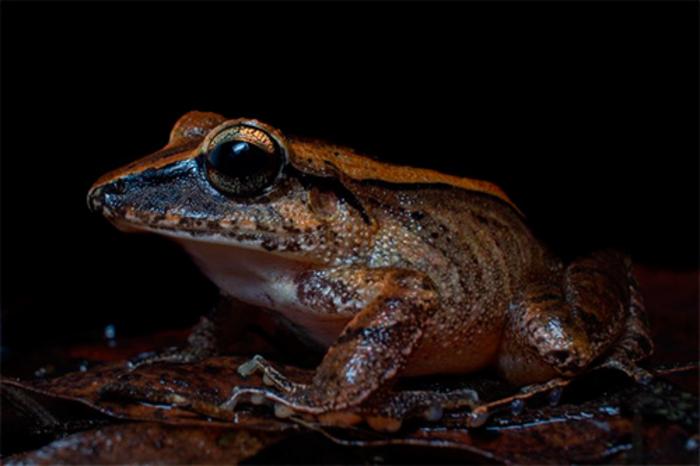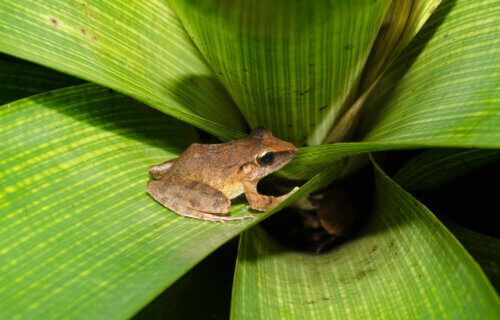SÃO PAULO, Brazil — In the lush depths of Brazil’s Atlantic Rainforest, a tiny frog has been hiding a secret weapon: a scream so intensely high-pitched that it’s inaudible to human ears. This groundbreaking discovery, reported in the journal Acta Ethologica, marks the first recorded use of ultrasound by amphibians in South America and sheds light on a never-before-seen defense mechanism against predators.
The star of this study is the Leaf litter frog (Haddadus binotatus), a species endemic to the Brazilian Atlantic Rainforest. When threatened, this diminutive amphibian unleashes a distress call that spans an astonishing frequency range of 7 kilohertz (kHz) to 44 kHz. For context, humans can typically hear sounds up to about 20 kHz – anything higher is considered ultrasound and is imperceptible to our ears.
“Some potential predators of amphibians, such as bats, rodents and small primates, are able to emit and hear sounds at this frequency, which humans can’t,” explains lead author Ubiratã Ferreira Souza, a former master’s student at the State University of Campinas, in a press release by the São Paulo Research Foundation (FAPESP). “One of our hypotheses is that the distress call is addressed to some of these, but it could also be the case that the broad frequency band is generalist in the sense that it’s supposed to scare as many predators as possible.”
The frog’s defensive strategy doesn’t stop at its ear-splitting scream. When emitting the distress call, the Leaf litter frog puts on quite a dramatic display. It raises the front of its body, opens its mouth wide, and jerks its head backward. Then, with its mouth partially closed, it lets loose the ultrasonic cry. It’s a performance worthy of a tiny amphibian Oscar.

The researchers stumbled upon this remarkable behavior by chance, recording the distress call on two separate occasions. Intrigued, they ran the recordings through specialized software and were stunned to discover the ultrasonic frequencies.
Given Brazil’s unparalleled amphibian diversity – the highest in the world with over 2,000 described species – the researchers believe that this ultrasonic defense mechanism might be more widespread than previously thought.
“In light of the fact that amphibian diversity in Brazil is the highest in the world, with more than 2,000 species described, it wouldn’t be surprising to find that other frogs also emit sounds at these frequencies,” notes Mariana Retuci Pontes, a co-author and PhD candidate at the same university.
In fact, Pontes may have inadvertently witnessed this behavior in another species during a visit to a state park in São Paulo. She observed what was likely a Hensel’s big-headed frog (Ischnocnema henselii) exhibiting similar defensive movements and vocalizations when she held it by the legs to take a photo. Intriguingly, a venomous lancehead pit viper was lurking nearby, adding weight to the idea that this was indeed an anti-predator response.
While ultrasonic communication is well-documented in mammals like whales, bats, rodents, and small primates, this study represents the first known instance of an amphibian using ultrasound to deter predators. Prior recordings of ultrasonic calls in three Asian amphibian species were found to be used for intraspecies communication rather than defense.
The discovery has opened up a new avenue of research, with the team now eager to investigate which predators are sensitive to the frog’s distress call, how they react to it, and whether the call aims to frighten them directly or attract their own natural enemies.
“Could it be the case that the call is meant to attract an owl that will attack a snake that’s about to eat the frog?” Souza muses.
In a world where amphibian populations are increasingly under threat, understanding their defense mechanisms and predator-prey dynamics is crucial. This study not only highlights the incredible adaptations of these oft-overlooked creatures but also underscores the importance of preserving the habitats where these fascinating interactions unfold.
So, the next time you’re wandering through the Brazilian rainforest and hear an eerie silence, remember: there might just be a tiny frog nearby, screaming its lungs out in a frequency beyond your perception, all in the name of survival.
